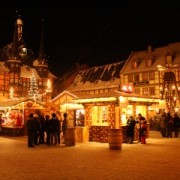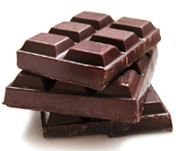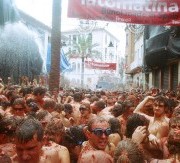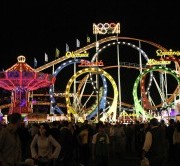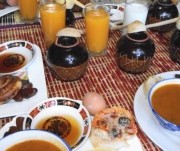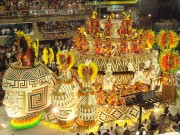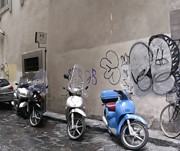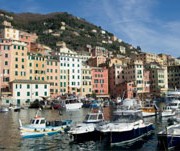Weihnachten – Christmas in Germany
The German Christmas season starts in the beginning of December when everyone decorates their homes. Towns and cities put up Christmas lights, people make their home made Plätzchen (Christmas biscuits) and supermarkets are filled with Schokolade (chocolate), Lebkuchen (gingerbread), Marzipan (marzipan) and other sugary Christmas treats. A German Christmas tradition that helps counting down the days until Christmas and is also a great excuse for eating chocolate before breakfast are Adventskalender (advent calendars). A lot of people make theirs or at least fill them themselves, and you can also buy different fillers from the supermarket: like chocolate, wine gums, toys or even cosmetics.
Another tradition that helps to count down the days before Christmas are Adventskränze (Christmas wreaths). They come in many different versions made from pine, wood, plastic or metal. But they are always round and feature four Advent candles. One of them is lit every Adventssonntag (Advent Sunday).
For decoration, there are a couple of typical German accessories: Rauchermännchen (German incense smokers), Schwibbögen (candle arches), a Krippe (nativity scene) or simply Lichterketten (holiday lights).
What’s great about the German Christmas season is that there is another festive day at the beginning of the month. On December 6th Germans celebrate Nikolaus (St. Nicholas Day). Children clean their boots and put them in front of their door. If they have been good all year, the Nikolaus will put sweets and treats in their shoes. If they have been bad, all they will get is a Rute (twigs).
Of course you can get some of the treats on the Weihnachtsmarkt (German Christmas market). If you’ve never been to one-you’re definitely missing out. Every city in Germany has at least one Christmas market with little stalls where you can buy presents, jewellery, and treats like Bratwurst, Flammkuchen (tarte flambée) gebrannte Mandeln (burnt sugar almonds) and everyone’s favourite: Glühwein (mulled wine)!
The Weihnachtsbaum (Christmas tree) is usually put up and decorated on the 24th of December. German Christmas tree decorations do not really differ from other countries. People just decorate their tree depending on their personal taste or family tradition.
On Heiligabend (Christmas Eve), before opening presents, some families go to church, others just go for a walk or have tea. Depending on which part of Germany children are from they either believe in the Weihnachtsmann (Santa Claus) or the Christkind (Baby Jesus) delivering their presents.
In Germany there are also a lot of regional differences when it comes to Christmas dinner. Most people keep it very simple though and have Würstchen (sausages) or Bratwurst with Kartoffelsalat (potato salad). Then, on Boxing day and Christmas day, the 1. und 2. Weihnachtsfeiertag it’s time for the festive meals: Gänse- or Entenbraten (roast goose or duck), Rotkohl (red cabbage), Grünkohl (kale), Maronen (chestnuts) and of course Klöße (dumplings).

